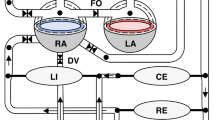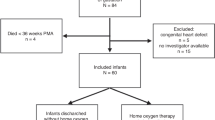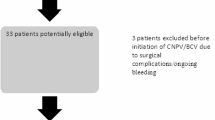Abstract
The aim of the present study was to assess with ultrasound the ductus venosus flow velocity in newborn lambs with increasing pulmonary artery pressures and to evaluate whether this is a useful method to detect elevated pulmonary artery pressure. The ductus venosus flow velocity was studied with pulsed-wave Doppler echocardiography in nine newborn lambs ≤30 h old. The lambs were anesthetized, mechanically ventilated, and instrumented to measure mean airway pressure and pulmonary artery and arterial blood pressures. A vascular occluder was placed around the main pulmonary artery. With mean pressures ranging from 20 to 50 mm Hg in the pulmonary artery, the ductus venosus flow velocity was examined. In seven lambs, the mean portal pressure and central venous pressure were also measured. With a stepwise increase in the pulmonary artery pressure, the minimum ductus venosus flow velocity during atrial systole decreased to a reversed flow, and the duration of this reversed flow component increased. The systolic forward peak flow velocity signal also gradually decreased. No changes were detected in the mean central venous or in the portal pressure with increasing pulmonary artery pressure or changes in ductus venosus flow. The flow velocity in the ductus venosus, which is higher than in other precordial veins, shows a reduction and even reversal of the nadir and an increase of the duration of reversed flow during atrial systole as a response to increased pulmonary artery pressure. Thus, Doppler ultrasound of the ductus venosus flow velocity may be a useful noninvasive diagnostic supplement to detect pulmonary hypertension of the newborn.
Similar content being viewed by others
Log in or create a free account to read this content
Gain free access to this article, as well as selected content from this journal and more on nature.com
or
Abbreviations
- DVa:
-
ductus venosus flow at atrial contraction
- DVa1:
-
reversed ductus venosus flow velocity at atrial contraction
- DVa2:
-
duration of the ductus venosus reversed flow at atrial contractio
- Fio2:
-
fraction of inspired oxygen
- Pao2:
-
arterial Pco2
- PAP:
-
mean pulmonary artery pressure
- PPHN:
-
persistent pulmonary hypertension of the newborn
References
Kiserud T, Eik-Nes SH, Blaas HG, Hellevik LR 1991 Ultrasonographic velocimetry of the fetal ductus venosus. Lancet 338: 1412–1414
Fugelseth D, Lindemann R, Liestøl K, Kiserud T, Langslet A 1997 Ultrasonographic study of ductus venosus in healthy neonates. Arch Dis Child 77: F131–F134
Fugelseth D, Lindemann R, Liestøl K, Kiserud T, Langslet A 1998 Postnatal closure of ductus venosus in preterm infants ≤32 wk. Early Hum Dev 53: 163–169
Fugelseth D, Kiserud T, Liestøl K, Langslet A, Lindemann R 1999 Ductus venosus blood velocity in persistent pulmonary hypertension of the newborn. Arch Dis Child 81: F35–F39
Chan KL, Currie PJ, Seward JB, Hagler DJ, Mair DD, Tajik AJ 1990 Comparison of three Doppler ultrasound methods in the prediction of pulmonary artery pressure. J Am Coll Cardiol 9: 549–554
Snider AR 1990 The ductus arteriosus: a window for assessment of pulmonary artery pressure?. J Am Coll Cardiol 15: 457–458
Musewe NN, Poppe D, Smallhorn JF, Hellman J, Whyte H, Smith B, Freedom RM 1990 Doppler echocardiographic measurement of pulmonary artery pressure from ductal Doppler velocities in the newborn. J Am Coll Cardiol 15: 446–456
Barcroft J 1946 Research on Prenatal Life, Vol I. Blackwell Scientific Publications, Oxford, pp 216–225
Kiserud T, Hellevik LR, Hanson M 1998 The blood velocity profile in the ductus venosus inlet expressed by the mean/maximum velocity ratio. Ultrasound Med Biol 24: 1301–1306
Kiserud T 1999 Hemodynamics of the ductus venosus. Eur J Obstet Gynecol Reprod Biol 84: 139–147
Huisman TWA, Stewart PA, Wladimiroff JW 1992 Ductus venosus blood flow velocity waveforms in the human fetus–a Doppler study. Ultrasound Med Biol 18: 33–37
Pennati G, Bellotti M, Ferrazzi E, Rigano S, Garberi A 1997 Hemodynamic changes across the human ductus venosus: a comparison between clinical findings and mathematical calculations. Ultrasound Obstet Gynecol 9: 383–391
Kiserud T 1997 In a different vein: the ductus venosus could yield much valuable information. Ultrasound Obstet Gynecol 9: 369–372
Friedman WF 1972 The intrinsic properties of the developing heart. Prog Cardiovasc Dis 15: 87–111
Reuss ML, Rudolph AM, Dae MW 1983 Phasic blood flow patterns in the superior and inferior venae cavae and umbilical vein of the sheep. Am J Obstet Gynecol 145: 70–78
Hasaart TH, de Haan J 1986 Phasic blood flow patterns in the common umbilical vein of fetal sheep during umbilical cord occlusion and the influence of autonomic nervous system blockade. J Perinat Med 14: 19–26
Ross J Jr 1979 Acute displacement of the diastolic pressure-volume curve of the left ventricle: role of the pericardium and the right ventricle. Circulation 59: 32–37
Meyer RA, Schwartz DC, Benzing G, Kaplan S 1972 Ventricular septum in right ventricular volume overload. Am J Cardiol 30: 349–354
Rein AJ, Sanders SP, Colan SD, Parness IA, Epstein M 1987 Left ventricular mechanics in the normal newborn. Circulation 76: 1029–1036
Rudolph CD, Rudolph AM 1998 Fetal and postnatal hepatic vasculature and blood flow. In: Polin RA, Fox WW (eds) Fetal and Neonatal Physiology, Vol II. WB Saunders Company, Philadelphia, pp 1442–1449
Kinsella JP, Abman SH 1995 Recent developments in the pathophysiology and treatment of persistent pulmonary hypertension of the newborn. J Pediatr 126: 853–864
Rudolph AM 1985 Distribution and regulation of blood flow in the fetal and newborn lamb. Circ Res 57: 811–821
Cullen S, Shore D, Reddington A 1995 Characterization of right ventricular diastolic performance after complete repair of tetralogy of Fallot. Circulation 91: 1782–1789
Vlahakes GJ, Turley K, Hoffman JIE 1981 The pathophysiology of failure in right ventricular hypertension: hemodynamic and biochemical correlations. Circulation 63: 87–95
Momma K, Takao A 1989 Right ventricular concentric hypertrophy and left ventricular dilatation by ductal constriction in fetal rats. Circ Res 64: 1137–1146
Appleton CP 1997 Hemodynamic determinants of Doppler pulmonary venous flow velocity components: new insights from studies in lightly sedated normal dogs. J Am Coll Cardiol 30: 1562–1574
Acknowledgements
The authors thank GE Vingmed Ultrasound A/S, Horten, Norway for the generous supply of ultrasound equipment, and Profs. Torvid Kiserud and Asbjørn Langslet for advice and critical comments.
Author information
Authors and Affiliations
Additional information
Supported by a grant from The Norwegian Heart and Lung Association.
Rights and permissions
About this article
Cite this article
Fugelseth, D., Leach, C., Morin, F. et al. Ductus Venosus Flow Velocity in Newborn Lambs during Increased Pulmonary Artery Pressure. Pediatr Res 47, 767–772 (2000). https://doi.org/10.1203/00006450-200006000-00014
Received:
Accepted:
Issue date:
DOI: https://doi.org/10.1203/00006450-200006000-00014



